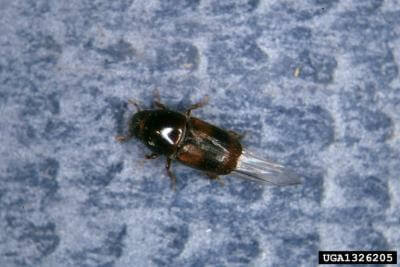
The banded elm bark beetle Scolytus schevyrewi Semenov is a bark beetle native to Asia, ranging from the Caspian Sea (Kazakhstan, Turkmenistan, and Uzbekistan) to Korea (Anonymous, 2004). The “chevy” beetle was first collected in insect traps set in Aurora, CO (a suburb of Denver), and Ogden, UT, in April 2003 as part of the USDA Forest Service-APHIS Rapid Detection and Response project (Duerr, August 2004, pers. comm.). However, it was quickly determined that the beetle is established from California to the Midwest (Anonymous, 2004), as far east as Michigan (Haack, 2004). State records demonstrate that S. schevyrewi was present in Clovis, New Mexico, as far back as 1998 (Anonymous, 2004).
The banded elm bark beetle was probably introduced as a hitchhiker in wood packaging with bark attached (Anonymous, 2004).
In the United States, the beetle has been observed to attack and kill drought-stressed Siberian elms (Ulmus pumila) (Anonymous, 2004). So far, the beetle has attacked only American (U. americana), English (U. procera), rock (U. thomasii), and Siberian elms in the United States; but in Asia it has a broader host range, including willows (Salix spp.), fruit trees such as apricot, cherry, and peach (Prunus spp.), and Russian olive (Elaeagnus angustifolia) (Anonymous, 2004).
The biology of S. schevyrewi is similar to that of S. multistriatus, another exotic bark beetle native to Europe introduced decades ago, which has been the principle vector of Dutch elm disease in the United States (Anonymous, 2004). However, the the banded elm bark beetle beetle appears to be more aggressive; in areas where it has become well established, it is much more abundant in dying elms than is S. multistriatus (Anonymous, 2004).
At this time, the banded elm bark beetle appears to pose a moderate risk to elms planted as shade trees or as windbreaks throughout the inland West, particularly during periods of drought (Anonymous, 2004).
USFS scientists and managers developed a conservation priority-setting framework for forest tree species at risk from pest & pathogens and other threats. The Project CAPTURE (Conservation Assessment and Prioritization of Forest Trees Under Risk of Extirpation) uses FIA data and expert opinion to group tree species under threat by non-native pests into vulnerability classes and specify appropriate management and conservation strategies. The scientists prioritized 419 tree species native to the North American continent. The analysis identified 15 taxonomic groups requiring the most immediate conservation intervention because of the tree species’ exposure to an extrinsic threat, their sensitivity to the threat, and their ability to adapt to it. Each of these 15 most vulnerable species, and several additional species, should be the focus of both a comprehensive gene conservation program and a genetic resistance screening and development effort. Banded elm bark beetle is not known to be a threat to any of these 15 most vulnerable species.
Sources
Anonymous. 2004. Scolytus schevyrewi Semenov – An Asian bark beetle new to the United States. https://www.fs.fed.us/r2/fhm/reports/pest_update_s-schevyrewi.pdf. Accessed August 2004
Duerr, Donald. August, 2004. dduerr(at)fs.fed.us, personal communication.
Haack, R. 2004. Forest Diversity and resistance to native exotic pest insects. International Union of Forest Research Organizations D7/D8, August 10 – 13, 2004, Hanmer Springs, New Zealand.
Potter, K.M., Escanferla, M.E., Jetton, R.M., Man, G., Crane, B.S., Prioritizing the conservation needs of US tree spp: Evaluating vulnerability to forest insect and disease threats, Global Ecology and Conservation (2019), doi: https://doi.org/10.1016/



